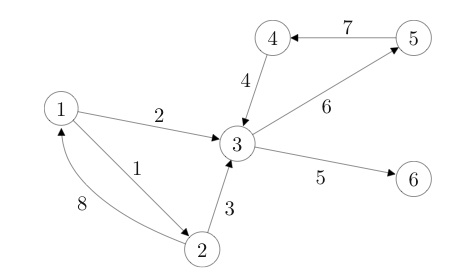Network Flows
Network models
Minimum cost network flow
Network models
What is a network?
We return to the network model described here. We consider a network (directed graph) having  nodes connected by
nodes connected by  directed arcs (ordered pairs
directed arcs (ordered pairs  ). We assume there is at most one arc from node
). We assume there is at most one arc from node  to node
to node  , and no self-loops. We define the arc-node incidence matrix
, and no self-loops. We define the arc-node incidence matrix  to be the matrix with coefficients
to be the matrix with coefficients  if arc
if arc  starts at node
starts at node  ,
,  if it ends there, and
if it ends there, and  otherwise. Note that the column sums of
otherwise. Note that the column sums of  are zero:
are zero:  .
.
 |
The figure shows the graph associated with the arc-node incidence matrix ![A = left[begin{array}{cccccccc} 1 & 1 & 0 & 0 & 0 & 0 & 0 & -1 -1 & 0 & 1 & 0 & 0 & 0 & 0 & 1 0 & -1 & -1 & -1 & 1 & 1 & 0 & 0 0 & 0 & 0 & 1 & 0 & 0 & -1 & 0 0 & 0 & 0 & 0 & 0 & -1 & 1 & 0 0 & 0 & 0 & 0 & -1 & 0 & 0 & 0 end{array}right] .](eqs/202116980273603297-130.png)
|
Flows
A flow (of traffic, information, charge) is represented by a vector  , and the {em total flow leaving node
, and the {em total flow leaving node  } is then
} is then  .
.
Minimum cost network flow
The minimum cost network flow problem has the LP form

where  is the cost of flow through arc
is the cost of flow through arc  ,
,  provide upper and lower bounds on
provide upper and lower bounds on  and
and  is an external supply vector. This vector may have positive or negative components, as it represents supply and demand. We assume that
is an external supply vector. This vector may have positive or negative components, as it represents supply and demand. We assume that  , so that the total supply equals the total demand. The constraint
, so that the total supply equals the total demand. The constraint  represents the balance equations of the network.
represents the balance equations of the network.
Maximum flow
A more specific example is the max flow problem, where we seek to maximize the flow between node  (the source) and node
(the source) and node  (the sink). It bears the form
(the sink). It bears the form

with  .
.